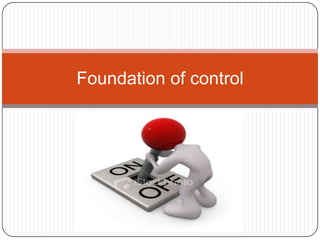
Foundations Of Control
- 2. Learning Outcomes Explain the nature and importance of control Describe the three steps in the control process Discuss the types of controls organizations and managers use Discuss contemporary issues in control
- 3. Management functions 1. Planning 2. Organizing 3. Leading 4. Controlling
- 4. What is Control? Control The management function that involves monitoring activities to ensure that they’re being accomplished as planned and correcting any significant deviations
- 6. What is the Control Process? Control Process A three-step process of measuring actual performance, comparing actual performance against a standard, and taking managerial action to correct deviations or to address inadequate standards
- 8. How Do Managers Measure? To determine actual performance, a manager must first get information about it. Thus, the first step in control is measuring Four common sources of information frequently used to measure actual performance are personal observation statistical reports oral reports written reports
- 9. What is Managing By Walking Around? Management By Walking Around (MBWA) When a manager is out in the work area interacting with employees
- 10. So “MBWA” is not that
- 11. How Do Managers Compare Performance to Planned Goals? Range of Variation The acceptable parameters of variance between actual performance and a standard Deviations outside this range need attention
- 13. What Management Action Can Be Taken? Immediate Corrective Action Corrective action that addresses problems at once to get performance back on track Basic Corrective Action Corrective action that looks at how and why performance deviated before correcting the source of deviation
- 14. When Does Control Take Place? Feedforward Control Control that takes place before a work activity is done Concurrent Control Control that takes place while a work activity is in progress Feedback Control Control that takes place after a work activity is done
- 16. How Do Managers Keep Track of Finances? In order to meet profitability goals, managers need financial controls Traditional financial measures managers might use include Ratio analysis Budget analysis
- 17. Financial Ratios by Type Liquidity ratios measure an organization’s ability to meet its current debt obligations Leverage ratios examine the organization’s use of debt to finance its assets and whether it’s able to meet the interest payments on the debt
- 18. Financial Ratios (cont.) Activity ratios assess how efficiently a company is using its assets. Profitability ratios measure how efficiently and effectively the company is using its assets to generate profit
- 20. How is an Organization’s Information Controlled? Managers deal with information controls in two ways: 1. as a tool to help them control other organizational activities 2. as an organizational area they need to control Management Information System (MIS) A system used to provide management with needed information on a regular basis
- 21. What is The Balanced Scorecard? Balanced Scorecard A performance measurement tool that looks at more than just the financial perspective
- 22. What are Contemporary Control Issues? Employee Theft Any unauthorized taking of company property by employees for their personal use
- 23. Contemporary Issues (cont.) Workplace Violence “According to the U.S. National Institute of Occupational Safety and Health”, 2 million American workers per year are victims of some type of workplace violence
